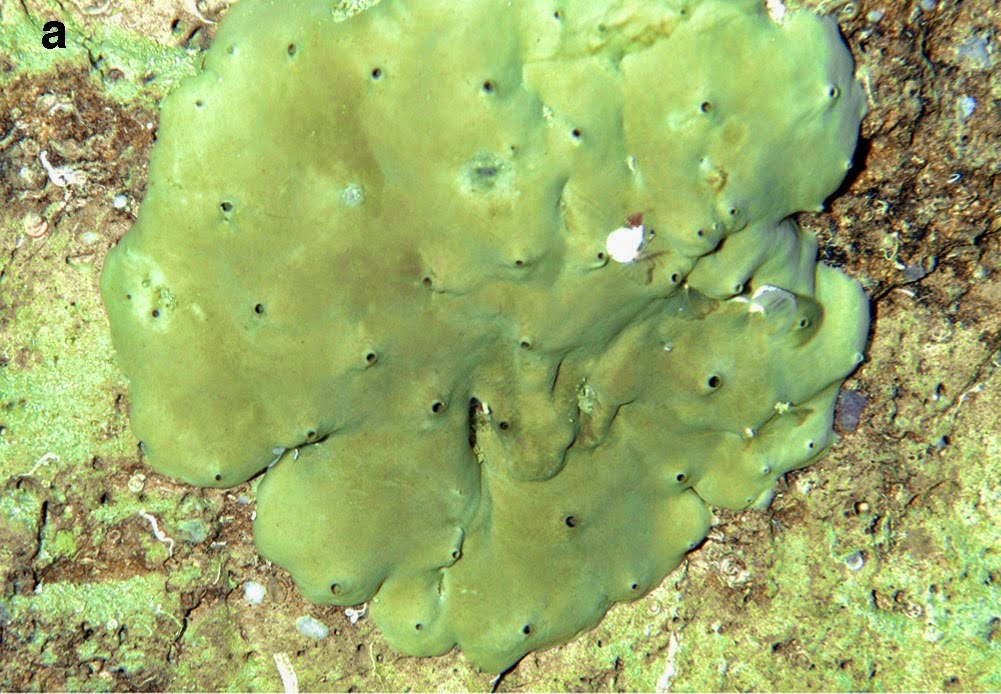The Homoscleromorph Sponge Oscarellalobularis
was long considered to be a widespread and highly variable species of
Demosponge, showing a variable morphology and coming in a variety of colours.
Since this species lacked any mineralized spicules, which were for a long time
the most reliable means of classifying Sponges, it received little attention
from taxonomists. However in 2012 it was revealed by molecular taxonomic
methods that the Homoscleromorpha, were not Demosponges at all, but were in
fact only very distantly related, and the subsequent promotion of the
Homoscleromorpha to full Class status, equivalent to the Demospongiae, Calcarea
andHexactinellida. This generated a great deal of interest in Homoscleromorph
Sponges, leading to molecular methods being applied to the taxonomy of the
group which have led to a far better understanding of relationships within the
group and revealed a number of new species.
In a paper published in the journal PLoS One on 30 May 2013, a team
of scientists led by Eve Gazave of the Institut Jacques Monod at the Université ParisDiderot and the Mediterranean Institute of Biodiversity and Ecology at Aix-MarseilleUniversité describe two new species of Sponges from populations off the coast
of Norway previously assigned to Oscarella lobularis,
as part of a wider study into genetic relationships within the genus Oscarella.
The first new species is named Oscarella bergenensis,
meaning ‘from Bergen’, as the species was described from specimens collected in
Bergen Fjords. This is an orange-red encrusting Sponge reaching 4-8 mm in
thickness, with its oscula (exhalent pores; Sponges are filter feeders which
take in water through tiny canal openings all over their bodies, but expel it
through one or more larger openings called ‘oscula’) raised 2-4 mm above the
surrounding surface, which is smooth with small folds. The species was
collected at depths of 3-10 m, on the stems of Kelps and granite rock-faces.
Oscarella bergenensis, external morphology in vivo. (o) Osculum. Gazave et al. (2014).
The second new species is named Oscarella nicolae,
in honour of Nicole Boury-Esnault, a Sponge biologist and taxonomist. The species
is a yellow-ivoryish encrusting Sponge 1.5-3.0 mm thick, with oscula on raised
cylindrical tubes ~3 mm above the surface of the Sponge. This species produces
a great deal of mucus, and was collected at depths of 3-10 m, on the stems of
Kelps and granite rock-faces.
Oscarella nicolae, external morphology in vivo. (o) Osculum. Gazave et al. (2014).
See also…
Reworked Late Ordovician Sponges have been collected from Miocene to
Pleistocene across a wide area of northern Europe for over two centuries. These
are associated with the course of the Baltic River...
Sponges
(Porifera) are generally considered to be the oldest extant animal group, with
a fossil record that extends considerably into the Precambrian; phylogenomic
analysis suggests they are the sister group to all other animals, which also
suggests an early origin for the group.
The shallow water reefs around Bonaire and Klein Curaçao in the
Caribbean Netherlands are well studied and are considered a biodiversity
hotspot, but the...
Follow Sciency Thoughts on Facebook.





